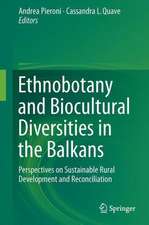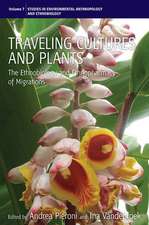Ethnobotany in the New Europe: Studies in Environmental Anthropology & Ethnobiology
Editat de Manuel Pardo-De-Santayana, Andrea Pieroni, Rajindra K. Purien Limba Engleză Paperback – 31 ian 2013
| Toate formatele și edițiile | Preț | Express |
|---|---|---|
| Paperback (1) | 303.11 lei 6-8 săpt. | |
| BERGHAHN BOOKS INC – 31 ian 2013 | 303.11 lei 6-8 săpt. | |
| Hardback (1) | 838.12 lei 6-8 săpt. | |
| BERGHAHN BOOKS INC – 10 iun 2010 | 838.12 lei 6-8 săpt. |
Preț: 303.11 lei
Nou
Puncte Express: 455
Preț estimativ în valută:
58.00€ • 60.76$ • 48.07£
58.00€ • 60.76$ • 48.07£
Carte tipărită la comandă
Livrare economică 09-23 aprilie
Preluare comenzi: 021 569.72.76
Specificații
ISBN-13: 9781782381242
ISBN-10: 1782381244
Pagini: 408
Dimensiuni: 152 x 229 x 21 mm
Greutate: 0.54 kg
Editura: BERGHAHN BOOKS INC
Seria Studies in Environmental Anthropology & Ethnobiology
ISBN-10: 1782381244
Pagini: 408
Dimensiuni: 152 x 229 x 21 mm
Greutate: 0.54 kg
Editura: BERGHAHN BOOKS INC
Seria Studies in Environmental Anthropology & Ethnobiology
Notă biografică
Manuel Pardo-de-Santayana is a Senior Lecturer of botany and ethnobotany at the Universidad Autonoma de Madrid. He has been researching contemporary and historical uses of Spanish medicinal and wild food plants, homegardens, and folk botanical taxonomies at the Royal Botanical Garden of Madrid (CSIC) and the School of Pharmacy (University of London) since 1995. Andrea Pieroni is an Associate Professor of plant biology and ethnobotany at the University of Gastronomic Sciences in Pollenzo, Northern Italy. He is the editor-in-chief of the Journal of Ethnobiology and Ethnomedicine and the President of the International Society of Ethnobiology. His research focuses on food and medical ethnobotany in the Mediterranean and in the Balkan areas, and among migrant communities and diasporas in Europe. Rajindra K. Puri is a Senior Lecturer in environmental anthropology and ethnobiology at the University of Kent at Canterbury, UK. While his primary research area is Indonesian Borneo, he also supervises M.Sc. and Ph.D. students who conduct ethnobotanical research in Europe. With Christian Vogl he co-organizes a summer field school in the Austrian Alps on methods in ethnobotany and works with the Global Diversity Foundation in Morocco, Malaysia and Namibia.
Cuprins
List of Figures List of Tables List of Appendixes Chapter 1. The Ethnobotany of Europe, Past and Present Manuel Pardo-de-Santayana, Andrea Pieroni and Rajindra K. Puri Chapter 2. People and Plants in Lepushe: Traditional Medicine, Local Foods and Post-communism in a Northern Albanian Village Andrea Pieroni Chapter 3. The Cultural Significance of Wild-gathered Plant Species in Kartitsch (Eastern Tyrol, Austria) and the Influence of Socioeconomic Changes on Local Gathering Practices Anja Christanell, Brigitte Vogl-Lukasser, Christian R. Vogl and Marianne Gutler Chapter 4. Local Innovations to Folk Medical Conditions: Two Major Phytotherapeutic Treatments from the Maltese Islands Timothy J. Tabone Chapter 5. Local Awareness of Scarcity and Endangerment of Medicinal Plants in Roussenski Lom Natural Park in Northern Bulgaria Hugo J. de Boer Chapter 6. 'My Doctor Doesn't Understand Why I Use Them': Herbal and Food Medicines amongst the Bangladeshi Community in West Yorkshire, U.K. Andrea Pieroni>, Hadar Zaman, Shamila Ayub and Bren Torry Chapter 7. Persistence of Wild Food and Wild Medicinal Plant Knowledge in a Northeastern Region of Portugal Ana Maria Carvalho and Ramon Morales Chapter 8. The Use of Wild Edible Plants in the Graecanic Area in Calabria, Southern Italy Sabine Nebel and Michael Heinrich Chapter 9. The Ecology and Use of Edible Thistles in Evora, Alentejo, Southeastern Portugal Maria Jose Barao and Alexandra Soveral Dias Chapter 10. Spring is Coming: The Gathering and Consumption of Wild Vegetables in Spain Javier Tardio Chapter 11. Plants as Symbols in Scotland Today Veerle Van den Eynden Chapter 12. The Botanical Identity and Cultural Significance of Lithuanian Jovaras: An Ethnobotanical Riddle Daiva Aeeskauskaite and Bernd Gliwa Chapter 13. Norway's Rosmarin(Rhododendron tomentosum) in Past and Present Tradition Torbjorn Alm and Marianne Iversen Chapter 14. Chamomiles in Spain: The Dynamics of Plant Nomenclature Manuel Pardo-de-Santayana and Ramon Morales Chapter 15. A Preliminary Study of the Plant Knowledge and Grassland Management Practices of English Livestock Farmers, with Implications for Grassland Conservation Jenny L. McCune Chapter 16. A Comparative Study of Rural and Urban Allotments in Gravesham, Kent, U.K. Christine Wildhaber Notes on Contributors Index
Recenzii
"The text itself is useful, entertaining, and informative. In addition, each chapter is a model for modern ethnobotanical studies. Rather than simply cataloguingplant use, each researcher analyzes the historical, societal, economic, or political aspects relevant to changes in human plant usage. Thus, the authors provide a true ethnobotanical resource that can be instructive to academic audiences" * Choice "The merit of the book is that it offers a glimpse in the cultural diversity of Europe as a reflection of its history and shows some of the trends in both local ecological knowledge and ethnobotanical research in the old continent - I recommend this book to any scholar interested in doing ethnobotanical research in Europe and to any student that wants to carry out ethnobotanical research in Europe." * Economic Botany









